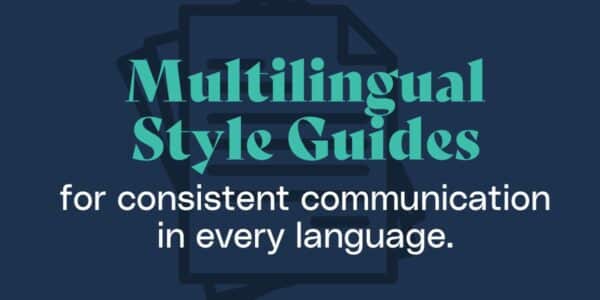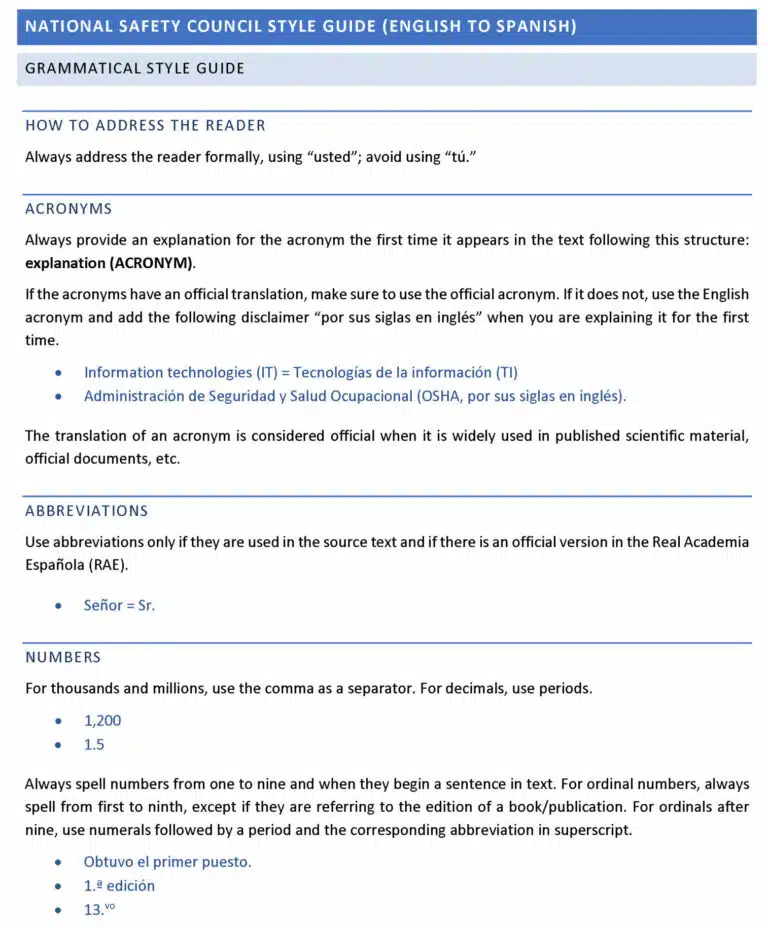
Learn about the importance of having a multilingual style guide and how to create one for your organization.
A style guide for translation can help make the daunting process of taking your business to a global audience a bit easier by answering some questions about your brand before translation begins.
Maintaining a clear and consistent message across diverse languages and cultures can be challenging. A multilingual style guide provides a roadmap to create and localize content needed as you conduct business across markets worldwide. This useful resource guides linguists on how to keep your message consistent and improve your company’s global communications.
Key topics covered in this article:
- What is a style guide for translation and what is it used for?
- Why is a translation style guide important?
- How does a multilingual style guide ensure consistency?
- How do you create a translation style guide?
- What are the key elements of a multilingual style guide?
- The Process: Create a Style Guide
What is a style guide for translation and what is it used for?
A multilingual style guide outlines guidelines and standards for adapting content to different languages and cultures.
A traditional style guide is a comprehensive outline, enabling writers to consistently produce company content that reinforces your brand. Content creators, proofreaders and copy editors use it to ensure consistency and coherence when communicating on behalf of your company. It defines voice, tone, and even visual elements that promote building and maintaining corporate brand identity. It also provides clear standards for language usage, grammar, punctuation, and formatting.
A multilingual style guide sames the same purpose for translation projects. It serves as a tool for your language partners that helps their linguists translate content to reach diverse audiences while preserving your brand’s identity. A style guide for localization will be a more robust document than a brand’s regular style guide because it aims to offer guidance on communicating across multiple languages and cultures.
Why is a translation style guide important?
Consistency is key in global communication. Developing a multilingual style guide creates a common reference point for everyone involved in content creation, from writers and editors to your language team—translators and localization experts. (This is especially important if you use multiple language service providers.) Clear instructions minimize the risk of random writing styles selected at will by your vendors, which do not properly present your company image and brand. The result is more valuable and effective localized content.
Multilingual style guides also streamline the content creation and localization process. Linguists on your team know that language choices in the localization style guide are approved, so they can rely on the document to answer questions and solve issues before the translation begins. When this internal channel is centralized to provide writing instructions that can be updated and deployed in real-time, localization projects notably reflect the benefit through improved decision-making in line with customer instructions. This is true even when these come from a wide range of actors across varying departments or branches and are delivered over the course of a long-term relationship.
How does a multilingual style guide ensure consistency?
Once developed, your multilingual style guide provides a framework for consistent and clear communication across languages and cultures. Take, for example, the use of slogans or taglines. It’s vitally important to consistently apply the same writing style rules when handling snappy one-liners of this type. Different translation approaches to this type of marketing copy will look sloppy. It could potentially be confusing or even offensive!
How do you create a translation style guide?
The goal is to have a clean, clear, concise, and organized high-level resource. Creating a multilingual style guide involves collaboration between stakeholders from different areas within your company. Consider the departments that create content most often (think marketing and branding) as well as those that work to develop global markets. You may even need to consider different style guides for different departments! At Interpro, we’ve seen examples from legal, human resources, internal communications, and production departments.
To develop an effective style guide for localization:
-
- Gather Input: Ask each department for information to understand the brand voice, target audience, and specific linguistic requirements for each target audience.
- Research and Consultation: Thoroughly research target languages and cultural aspects of target markets, consulting with native speakers and experts. As languages are organic, speak with in-country linguists immersed in each culture.
- Collaborate with Translators and your local employees: Involve linguistic experts in developing a robust and practical guide. Additionally, enlist the help of your most valuable asset, your local employees. Create a formal global employee network to review your multilingual style guide.
- Define Guidelines: Establish clear guidelines for language, tone, formatting, and cultural considerations based on the gathered insights.
- Document and Distribute: Compile the guidelines into a well-organized document and make it accessible to all team members and localization partners. Then, training sessions will be conducted to familiarize stakeholders with the style guide and ensure consistent implementation.
What are the key elements of a multilingual style guide?
A comprehensive style guide for localization should address the following elements:

Example of a style guide for translation
- Language and Grammar: What languages will you need to address? Are there any terms that should be kept in English and not translated? Specify preferred language variants (such as dialects), unique grammar rules, punctuation, and sentence structure guidelines for each target language.
- Target Audience: Understanding who you’re communicating with is crucial. Tailor the language level, formality, and cultural references to resonate with your target audience. You can gather targeted input from key departments (marketing, sales) about brand voice and audience language preferences. Analyze existing brand materials and identify cultural nuances.
- Tone of Voice: Define the appropriate tone and style for your brand’s voice, considering cultural norms and audience preferences. It is also helpful to outline a preference for formal or casual language, as this can vary in specific languages and for specific targets.
- Language Variants: If targeting multiple regions with different language dialects (e.g., British vs. American English, Latin American Spanish variations), clarify the preferred variant.
- Cultural Considerations: Provide insights into cultural nuances, taboos, symbols, and idiomatic expressions to avoid unintentional misunderstandings or offense. Be sure to explore difficult translations requiring a custom solution, like abbreviations. We cover the topic in depth with 8 tips to communicate with a cross-cultural audience. Use gender-neutral language and avoid idioms or references specific to one culture.
- Formatting and Layout: Provide guidelines to maximize readability in different languages. Outline any formatting preferences, such as date formats, numbering styles, and bullet point usage. Consistency in formatting creates a polished look across languages.
Multilingual Glossaries for Specific Terminology: Consider a translation glossary for a document that includes a comprehensive list of key terms and industry-specific or brand-specific terminology with approved translations. A glossary can also help you save money by reducing the required research and potential revisions to your content!
Best Practice for Maintaining a Multilingual Style Guide: Consistency
Once you’ve created your style guide for localization, the work is not over. Localization trends, market preferences, and corporate style evolve, so it’s important to schedule periodic reviews of your multilingual style guide. You can then incorporate feedback, address emerging trends, reflect language and cultural norm changes, and adapt to changing market dynamics. You should also use a version control process to keep all team members current and working with the latest version.
The Process: Create a Style Guide
Does creating and maintaining a multilingual style guide seem overwhelming? Interpro can coordinate that process! We help with conducting research and establishing the key elements for your communications. With our global network of professional in-country linguists and multi-levels of quality assurance, we will ensure your message is delivered effectively and can promote cultural awareness.
- Schedule the process and delivery timeline. When do you get a draft to review? When will your team reasonably be able to provide feedback? What is your timeline to finalize the project?
- Provide a complete set of reference files, establish your source and target language, and outline what should be included in your multilingual style guide. Because Interpro is a translation and localization partner, we can help you create the guide and decide what to include.
- Identify an internal reviewer at your company. Ideally, this should be someone who has professional-level writing capabilities in the target language and good understanding of the source language. An internal reviewer is important because the localization style guide content is highly specific to your business. Having someone “on the inside” review the document helps set the tone for your translator to accurately present the company brand on all future projects for any department.
- Interpro reviews all items provided. This includes any documents you’ve had translated by other vendors, internally created content and other English content that already exists within your business.
- Prepare for collaboration with your language team. Some industry-specific writing style choices, unique to your business model, or specific to your local region may need further discussion to ensure the creation of the best multilingual style guide.
Ready to get started?
Interpro offers complimentary localization consultations if you think you’re ready to start translating but don’t know where to begin.
A well-crafted multilingual style guide is invaluable for ensuring effective communication and maintaining brand consistency in global markets. Implementing this resource can empower your internal and external teams to navigate the complexities of localization with confidence and clarity.
Category: Translation
Tags: Guides
Service: Document Translation, Style Guide Development, Translation Services
Don't forget to share this post!
Stay Updated with Interpro
Subscribe to our newsletter for the latest updates and insights in translation and localization.







